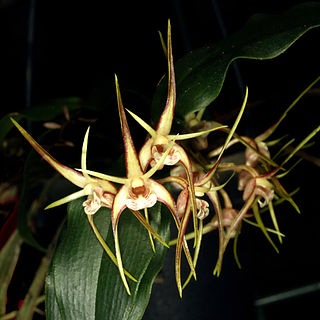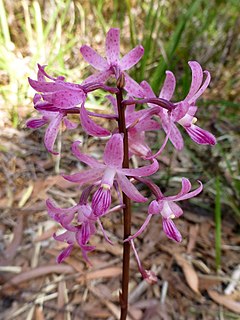
Dipodium, commonly known as hyacinth orchids, is a genus of about forty species of orchids native to tropical, subtropical and temperate regions of south-east Asia, New Guinea, the Pacific Islands and Australia. It includes both terrestrial and climbing species, some with leaves and some leafless, but all with large, often colourful flowers on tall flowering stems. It is the only genus of its alliance, Dipodium.

Dipodium punctatum, commonly known as the blotched hyacinth-orchid, is a leafless orchid that is a native to eastern and south-eastern continental Australia. In summer it produces a tall flowering stem with up to sixty pale to bright pink flowers with heavy red blotches. A widespread and common species it is often confused with D. roseum and some authorities regard it as a synonym of D. squamatum.

Dipodium elegantulum, commonly known as the elegant hyacinth orchid, is a leafless orchid that is endemic to Queensland. In spring and summer it has up to sixty pale to dark pink flowers with a few darker spots and streaks near the tips, on a tall flowering stem.

Dendrobium tetragonum, commonly known as the tree spider orchid, is a variable species of epiphytic or lithophytic orchid endemic to eastern Australia. Tree spider orchids are unusual in having pendulous pseudobulbs that are thin and wiry near the base then expand into a fleshy, four-sided upper section before tapering at the tip. There are only a few thin but leathery leaves at the end of the pseudobulbs and up to five flowers on relatively short flowering stems. To allow for the variations in the species there are five subspecies and a variety, some with a unique common name.

Dipodium roseum, commonly known as rosy hyacinth-orchid or pink hyacinth-orchid, is a leafless saprophytic orchid found in east and south-eastern Australia. In summer it produces a tall flowering stem with up to fifty pale pink flowers with small, dark red spots. A widespread and common species it is often confused with D. punctatum but has darker, less heavily spotted flowers.

Dipodium variegatum, commonly known as the slender hyacinth-orchid, or blotched hyacinth-orchid, is a leafless mycoheterotrophic orchid that is endemic to south-eastern Australia. It forms mycorrhizal relationships with fungi of the genus Russula.
Dipodium campanulatum, commonly known as the bell-flower hyacinth orchid, is a leafless mycoheterotroph orchid that is endemic to south-eastern Australia. In summer it has up to thirty five white flowers with large, dark red spots and blotches.

Dipodium stenocheilum, commonly known as tropical hyacinth-orchid, is a leafless saprophytic orchid that is endemic to northern Australia. For most of the year the plant is dormant but in summer it produces a tall flowering stem with up to twenty five white flowers with purple spots and a mauve labellum.

Dipodium ensifolium, commonly known as leafy hyacinth-orchid, is an orchid species that is endemic to north-east Queensland. It has sword-shaped leaves and up to twenty pink to mauve flowers with purplish spots and blotches.
Dipodium pulchellum is an almost leafless orchid that is endemic to north-east New South Wales and south-east Queensland in Australia. Up to forty pink flowers with darker blotches are borne in summer and winter on flowering spikes up to 90 cm (40 in) long.
Caladenia branwhitei, commonly known as the Bethungra spider orchid, is a plant in the orchid family Orchidaceae and is endemic to southern New South Wales. It has a single dull green leaf and one or two, usually dark red to maroon-coloured flowers. It is only known from three areas near Bethungra where it grows in ironbark forest.
Caladenia cadyi is a plant in the orchid family Orchidaceae and is endemic to the south coast of New South Wales. It has a single dull green leaf with purple blotches near the base, and a single greenish cream to cream flower with pink to reddish markings. It was only known from a single population which has been bulldozed and replaced with a pine plantation so that it is now probably extinct.
Genoplesium insigne, commonly known as the dark midge orchid or Wyong midge orchid, and as Corunastylis insignis in Australia, is a small terrestrial orchid which is endemic to New South Wales. It has a single thin leaf and up to twelve dark purple to dark reddish purple flowers. It is mostly found in heath on the Central Coast and only around fifty plants survive.
Genoplesium morinum, commonly known as the mulberry midge orchid and as Corunastylis morina in Australia, is a small terrestrial orchid endemic to New South Wales. It has a single thin leaf fused to the flowering stem and up to twenty crowded, dark reddish purple flowers. It has been known as "mulberries on sticks".
Genoplesium superbum, commonly known as the pink midge orchid or superb midge orchid, is a small terrestrial orchid which is endemic to New South Wales. It has a single thin leaf and up to fifteen dark pinkish-purple flowers which lean downwards. It is listed as "endangered" in New South Wales because of its limited distribution and disturbance of its habitat.

Diuris semilunulata, commonly known as the late leopard orchid, is a species of orchid that is endemic to New South Wales and the Australian Capital Territory. It has two grass-like leaves and up to five orange-coloured flowers with brown and purple blotches.
Chiloglottis trullata, commonly known as the triangular orchid, is a species of orchid endemic to Queensland. It has two dark green leaves and a single small, green or pinkish flower with a shiny, dark reddish black, insect-like callus surrounded by reddish club-shaped calli covering most of the upper surface of the labellum.
Calochilus pruinosus, commonly known as the mallee beard orchid, is a species of orchid endemic to southern continental Australia. It has up to fifteen dull greenish, pinkish or brownish flowers with red lines and a labellum with a purplish "beard", but is leafless.
Calochilus uliginosus, commonly known as the swamp beard orchid, is a species of orchid endemic to Western Australia. It has a single dark green leaf with a reddish purple base and up to seven greenish to brownish flowers with red lines and a labellum with a reddish purple beard.
Sarcochilus weinthalii, commonly known as the blotched butterfly orchid, is a small epiphytic orchid endemic to eastern Australia. It has between three and seven thin, leathery, yellowish green leaves and up to twelve cream-coloured flowers with large purple or reddish blotches.









